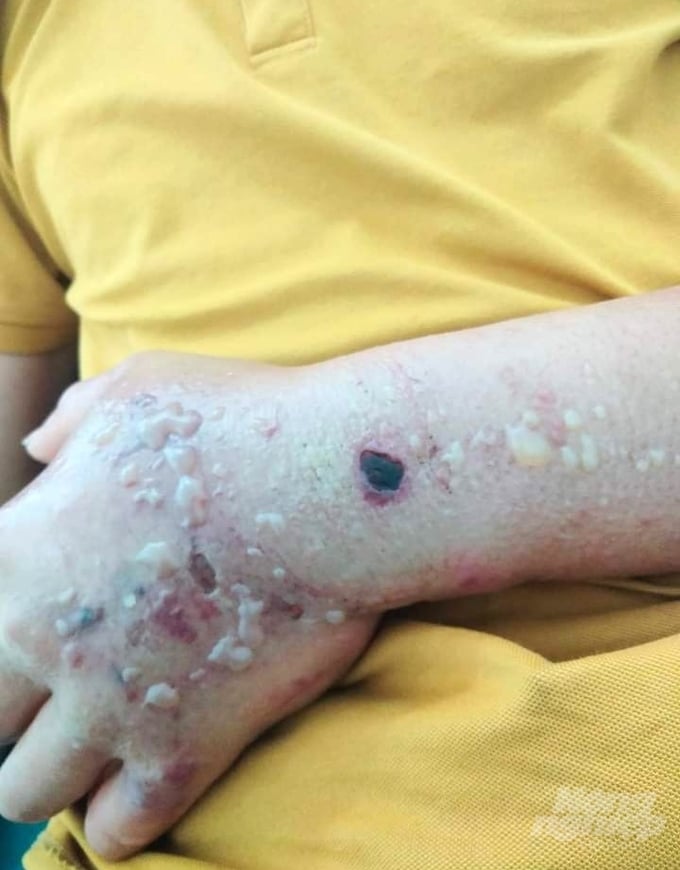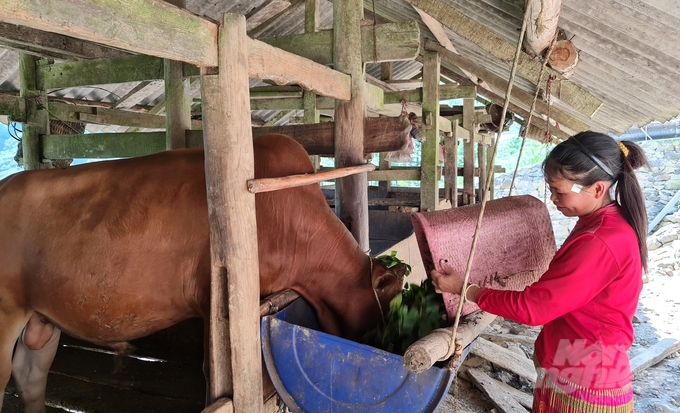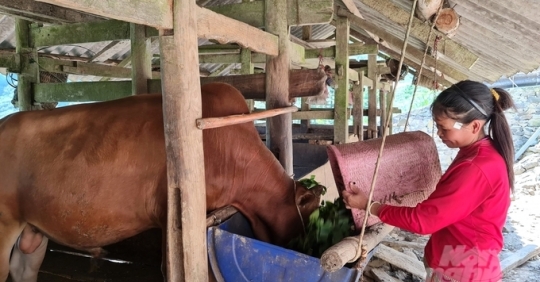
Patient Lau Mi So, Quan Xi Village, Lung Pu Township, Meo Vac District has anthrax in his arm. Picture: Dao Thanh.
Mr. Trinh Van Binh, director of Ha Giang Provincial Livestock Husbandry and Animal Health Sub-department, said that on May 14, 2023, the sub-department received information from the provincial epidemic control center at Mr. Lau Mi So of Quan Xi Village, Lung Pu Township Meo Vac, suffering from anthrax, is being treated at Ha Giang Province General Hospital.
Accordingly, in late April 2023, Mr. So bought a dead three-year-old cow and slaughtered it in the household of Mr. Lau Nhia Po, Pac Cam Village, Khau Vai Township, Meo Vac District. The test results showed that the patient was positive for anthrax.
After investigation and verification by Ha Giang provincial authorities, Mr. Lau Nhia Po’s family cow died on April 26, 2023 from bleeding in two nostrils. Pac Cam Village is known to be the village where an old outbreak of anthracnose disease in humans and livestock occurred in 2008, 2017 and 2020. In this outbreak, 10 people participated in slaughtering and eating meat. Cows including 7 individuals in Khau Vai community, 1 individual in Lung Pu community, 1 individual in Pa Vi community and 1 individual in Son Vi community.
After receiving information on the situation of cows infected with anthracnose disease spreading to humans, Ha Giang Province Department of Agriculture and Rural Development coordinated with Meo Vac district authorities to ship 247 liters of chemicals for sanitation and hygiene purposes. Disinfection in the outbreak and risk areas.
The Central Veterinary Diagnostic Center took 14 samples for analysis, including 6 blood samples, 6 swab samples and 2 soil samples. Meo Vac District Animal Husbandry and Veterinary Medicine Station appoints an official to direct epidemic prevention in Khau Vai township.
The Khau Vai Township People’s Committee has instructed the township veterinary staff and village officials to directly lead the epidemic prevention in the township. Instructing and mobilizing people to clean up, collect livestock waste and dispose of it properly…

The Department of Agriculture and Rural Development of Ha Giang Province recommends people take proactive measures to prevent anthracnose disease in humans and livestock, and definitely not eat dead or sick buffalo or cows. Picture: Dao Thanh.
Currently, the total herd of cattle in Meo Vac district is more than 49,800 animals, including about 4,000 buffalo, more than 29,200 cows and about 16,600 goats.
As part of the vaccination, the district has administered anthracnose vaccination to more than 26,000 animals, accounting for 78.3% of the total herd of buffalo and cows.
In the Khau Vai municipality in particular, the total buffalo herd numbers more than 3,400 animals and about 1,300 goats. The results of vaccination against anthracnose disease were 2,530 animals and reached 74%. The community of Lung Pu has a total herd of 2,100 cows. The results of the anthrax vaccination amount to 1,700 animals, which corresponds to 81% of the total herd of buffalo and cows.
Ms. Ninh Thi Vi, vice chairwoman of Khau Vai township in Meo Vac district, said Mr. Lau Nhia Po’s family had four cows with anthracnose disease through the inspection. Previously, Mr. Lau Nhia Po’s family bull was vaccinated against anthracnose disease on April 21, 2023. After the vaccination, the family did not let the cow rest, but instead let her plow for two consecutive days.
Currently, the local government is assisting Mr. Po’s family and two other households in the outbreak-hit region to relocate to a new location to ensure that anthracnose disease does not spread to humans. Regarding Mr. Lau Mi So’s health, after being hospitalized, his health was stable and he was released. Local health authorities are also recommending that patients continue to monitor their health.
The Ministry of Agriculture and Rural Development of Ha Giang Province also recommended that anthrax (also called anthrax) is a dangerous acute infectious disease in warm-blooded animals and humans. The disease is caused by bacteria. Under adverse environmental conditions, bacteria produce spores and anthracnose spores that can survive in the natural environment for many years.
The functional sector, municipalities and people in Ha Giang province urgently need to check the cattle that have not been vaccinated against anthrax and immediately organize additional vaccination for the herd. When monitoring the epidemic situation, if cattle show signs of illness or death, they must report the date to local authorities and specialized bodies. Carry out cleaning and collection of manure, garbage and animal waste in households. Set up roadblocks on the roads leading in and out of the epidemic area to prevent the movement of livestock and livestock products in and out of the epidemic area.

